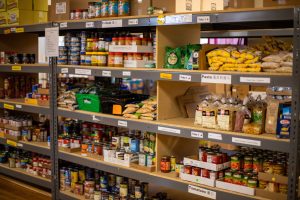Written by Samantha Walter-Cano, Edited by Olivia Zugay
Human Rights Month: Food Insecurity
With the rise in prices and the impact of COVID-19 over the past few years, access to food has become harder for many around the world. This December is Human Rights Month, and one of the most basic rights in our world is the right to food. However, there is a large population of people all over the world who do not have access to food, and those numbers keep increasing. According to a UN report, global hunger “rose to as many as 828 million in 2021,” and “Nearly 924 million people (11.7% of the global population) faced food insecurity at severe levels” (WHO). Those numbers are significantly higher than they were the previous year. To combat world hunger, it is important to bring awareness to what food insecurity is and the implications it has on health.
What is Food Insecurity?
According to Feeding America, food insecurity is defined as “a lack of consistent access to enough food for every person in a household to live an active, healthy life.” Food insecurity is what can eventually lead to food hunger. While these two terms are often used interchangeably, food hunger refers to the actual feeling of being hungry. Food insecurity can be caused by several factors:
- Poverty or low income
- Unemployment
- Lack of affordable housing
- Health conditions and minimum access to healthcare

While food insecurity can lead to hunger, it can also lead to a decrease in diet quality without actually changing the consumption of food. This is called low food security, or by its old name, food insecurity without hunger. Very low food security is food insecurity that results in hunger. While low food security may not lead to hunger, it can lead to many health problems and complications.
Effects of Food Insecurity
Obesity
While they may seem in opposition to one another, food insecurity can frequently lead to obesity. This is due to many reasons. For many, food insecurity is caused by a lack of money and financial resources. Unfortunately, when it becomes time to eat, unhealthier options are often considered cheaper than the healthier choices. One example of this is the dollar menu at fast food restaurants. Many people also lack transportation to supermarkets and large grocery stores that may carry healthier foods that are inexpensive. These individuals may only have access to small convenience stores that have little to no options for affordable healthy foods. These convenience stores instead carry things such as chips and soda. The USDA calls this living in a food desert. According to a 2014 study by Feeding America, 79% of households served by Feeding America buy inexpensive and unhealthy food to stretch their budget. This is especially true for those living in low-income communities in highly populated urban areas. Obesity is a risk factor for chronic health complications such as high cholesterol, high blood pressure, type 2 diabetes, and heart disease.
Choosing Between Health and Food
Another effect of food insecurity is an increase in health problems. Not because of a diet, but rather because when people must choose between spending on food and or healthcare. Some people cannot afford to feed themselves as well as afford medicine or healthcare for medical conditions. According to the same 2014 study by Feeding America, 66% of families served by Feeding America have to choose between food and medical care. This means that many families may dismiss any medical symptoms they are feeling; all to afford food on the table. This could be associated with the higher overall death rates among people reporting food insecurity (AHA).
Education
Food insecurity is damaging to a person of any age but is extremely devastating for children. In 2017, the USDA estimated that “more than 12 million children in the United States live in food-insecure households” (Feeding America). As discussed, this can cause several problems with a child’s health. However, food insecurity can also affect children’s education. According to widespread research, problems associated with food insecurity follow children into the classroom, resulting in poor academic performance. According to a 2005 article published in the Journal of Nutrition, “Among 6- to 12-year-old children, food insufficiency was associated with poorer mathematics scores, grade repetition, absenteeism, tardiness, visits to a psychologist, anxiety, aggression, psychosocial dysfunction, and difficulty getting along with other children” (Jyoti et al.). Food insecurity is also shown to reduce a student’s chance of graduating. This causes young adults who are not prepared for the workforce to work in low-income jobs. This restarts the cycle of food insecurity and its effects.
Food Insecurity in Florida
Data from Feeding America approximates that about 3,315,500 Florida residents are reported as suffering from food insecurity. “Overall, Florida is ranked 10th in food insecurity and 8th in child food insecurity” (Savelle & O’Neal). Florida’s two most food-insecure counties are Gadsden and Leon.
How You Can Help

While it is virtually impossible to help everyone suffering from food insecurity by yourself, there are many ways to help your local community by aiding those who are food insecure. Donating is one of the most popular ways to help fight food insecurity. Whether that is in the form of money, time, or food, any little thing helps. Another way is to bring awareness to any legislative bills that may address food insecurity. It is important to be aware of what your local government is doing in efforts to reduce food insecurity, and how it can be improved. This includes increasing or continuing funding for programs such as SNAP and the WIC. Feeding America also has several local banks where you can donate or volunteer your time. Banks near you can be found using the link below: Find Your Local Food Bank | Feeding America
References
8 ways to help people who are food insecure. United Way of Central Florida. (2021, November 17). Retrieved December 14, 2022, from https://uwcf.org/8-ways-to-help-people-who-are-food-insecure/
Feeding America. (2019). 2019 Child food insecurity – Feeding America. Retrieved December 14, 2022, from https://www.feedingamerica.org/sites/default/files/2019-05/2017-map-the-meal-gap-child-food-insecurity_0.pdf
Jyoti, D. F., Frongillo, E. A., & Jones, S. J. (2005, December 1). Food insecurity affects school children’s academic performance, weight gain, and social skills. The Journal of Nutrition. Retrieved December 14, 2022, from https://pubmed.ncbi.nlm.nih.gov/16317128/
Precker, M. (2021, September 22). Food insecurity’s long-term health consequences. www.heart.org. Retrieved December 14, 2022, from https://www.heart.org/en/news/2021/09/22/food-insecuritys-long-term-health-consequences
Savellle, R., & O’Neal, L. T. J. (2017, April 20). Food insecurity and obesity. askifas- EDIS. Retrieved December 14, 2022, from https://edis.ifas.ufl.edu/publication/FY1473
Stevens, S. (2020, July 7). Food for thought: How food insecurity affects a child’s education. American Youth Policy Forum. Retrieved December 14, 2022, from https://www.aypf.org/blog/food-for-thought-how-food-insecurity-affects-a-childs-education/
What are food deserts and why do they exist?: FFAC. Factory Farming Awareness Coalition. (2022, June 15). Retrieved December 14, 2022, from https://ffacoalition.org/articles/food-deserts/
What is food insecurity? Feeding America. (n.d.). Retrieved December 14, 2022, from https://www.feedingamerica.org/hunger-in-america/food-insecurity
World Health Organization. (2022, July 6). UN Report: Global Hunger Numbers rose to 828 million in 2021. World Health Organization. Retrieved December 14, 2022, from https://www.who.int/news/item/06-07-2022-un-report–global-hunger-numbers-rose-to-as-many-as-828-million-in-2021
 2
2
